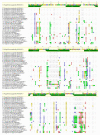Rapid Detection of Pityophthorus juglandis (Blackman) (Coleoptera, Curculionidae) with the Loop-Mediated Isothermal Amplification (LAMP) Method
- PMID: 34067342
- PMCID: PMC8224600
- DOI: 10.3390/plants10061048
Rapid Detection of Pityophthorus juglandis (Blackman) (Coleoptera, Curculionidae) with the Loop-Mediated Isothermal Amplification (LAMP) Method
Abstract
The walnut twig beetle Pityophthorus juglandis is a phloem-boring bark beetle responsible, in association with the ascomycete Geosmithia morbida, for the Thousand Cankers Disease (TCD) of walnut trees. The recent finding of TCD in Europe prompted the development of effective diagnostic protocols for the early detection of members of this insect/fungus complex. Here we report the development of a highly efficient, low-cost, and rapid method for detecting the beetle, or even just its biological traces, from environmental samples: the loop-mediated isothermal amplification (LAMP) assay. The method, designed on the 28S ribosomal RNA gene, showed high specificity and sensitivity, with no cross reactivity to other bark beetles and wood-boring insects. The test was successful even with very small amounts of the target insect's nucleic acid, with limit values of 0.64 pg/µL and 3.2 pg/µL for WTB adults and frass, respectively. A comparison of the method (both in real time and visual) with conventional PCR did not display significant differences in terms of LoD. This LAMP protocol will enable quick, low-cost, and early detection of P. juglandis in areas with new infestations and for phytosanitary inspections at vulnerable sites (e.g., seaports, airports, loading stations, storage facilities, and wood processing companies).
Keywords: bark beetle; invasive species; molecular identification; thousand canker disease; walnut.
Conflict of interest statement
The authors declare no conflict of interest.
Figures








Similar articles
-
LAMP Reaction in Plant Disease Surveillance: Applications, Challenges, and Future Perspectives.Life (Basel). 2024 Nov 26;14(12):1549. doi: 10.3390/life14121549. Life (Basel). 2024. PMID: 39768257 Free PMC article. Review.
-
Thousand Cankers Disease in Walnut Trees in Europe: Current Status and Management.Pathogens. 2023 Jan 19;12(2):164. doi: 10.3390/pathogens12020164. Pathogens. 2023. PMID: 36839436 Free PMC article. Review.
-
First Record of Thousand Cankers Disease Fungal Pathogen Geosmithia morbida and Walnut Twig Beetle Pityophthorus juglandis on Juglans regia in Europe.Plant Dis. 2014 Oct;98(10):1445. doi: 10.1094/PDIS-07-14-0719-PDN. Plant Dis. 2014. PMID: 30703957
-
First Record of Thousand Cankers Disease Geosmithia morbida and Walnut Twig Beetle Pityophthorus juglandis on Juglans nigra in Europe.Plant Dis. 2014 May;98(5):696. doi: 10.1094/PDIS-10-13-1027-PDN. Plant Dis. 2014. PMID: 30708556
-
Behavioral Responses of Pityophthorus juglandis (Coleoptera: Curculionidae: Scolytinae) to Volatiles of Black Walnut and Geosmithia morbida (Ascomycota: Hypocreales: Bionectriaceae), the Causal Agent of Thousand Cankers Disease.Environ Entomol. 2018 Apr 5;47(2):412-421. doi: 10.1093/ee/nvx194. Environ Entomol. 2018. PMID: 29373654
Cited by
-
LAMP Reaction in Plant Disease Surveillance: Applications, Challenges, and Future Perspectives.Life (Basel). 2024 Nov 26;14(12):1549. doi: 10.3390/life14121549. Life (Basel). 2024. PMID: 39768257 Free PMC article. Review.
-
Stilbocrea banihashemiana sp. nov. a New Fungal Pathogen Causing Stem Cankers and Twig Dieback of Fruit Trees.J Fungi (Basel). 2022 Jun 30;8(7):694. doi: 10.3390/jof8070694. J Fungi (Basel). 2022. PMID: 35887450 Free PMC article.
-
Diagnostic Tool for the Identification of Bactrocera dorsalis (Hendel) (Diptera: Tephritidae) Using Real-Time PCR.Insects. 2024 Jan 8;15(1):44. doi: 10.3390/insects15010044. Insects. 2024. PMID: 38249050 Free PMC article.
-
Thousand Cankers Disease in Walnut Trees in Europe: Current Status and Management.Pathogens. 2023 Jan 19;12(2):164. doi: 10.3390/pathogens12020164. Pathogens. 2023. PMID: 36839436 Free PMC article. Review.
-
Loop-Mediated Isothermal Amplification (LAMP) and SYBR Green qPCR for Fast and Reliable Detection of Geosmithia morbida (Kolařik) in Infected Walnut.Plants (Basel). 2022 May 3;11(9):1239. doi: 10.3390/plants11091239. Plants (Basel). 2022. PMID: 35567240 Free PMC article.
References
-
- Tisserat N., Cranshaw W., Leatherman D., Utley C., Alexander K. Black Walnut Mortality in Colorado Caused by the Walnut Twig Beetle and Thousand Cankers Disease. Plant Heal. Prog. 2009;10:10. doi: 10.1094/PHP-2009-0811-01-RS. - DOI
-
- Seybold S.J., Dallara P.L., Hishinuma S.M., Flint M.L. Detecting and Identifying the Walnut Twig Beetle: Monitoring Guidelines for the Invasive Vector of Thousand Cankers Disease of Walnut. [(accessed on 15 January 2021)];2013 Available online: http://ipm.ucanr.edu/PDF/PESTNOTES/WTB_trapping.pdf.
LinkOut - more resources
Full Text Sources

